Wimbledon: Coco Gauff on overnight recognition, Michelle Obama & learning to drive
Coco Gauff speaks to BBC Sport’s Sue Barker about becoming an overnight celebrity after making her Wimbledon debut last year.
Coco Gauff speaks to BBC Sport’s Sue Barker about becoming an overnight celebrity after making her Wimbledon debut last year.
Swiss entered contest with 4-0 ATP Head2Head record against Falla
In his first match at The Championships since one of his greatest Wimbledon triumphs, Roger Federer narrowly avoided an opening day upset at Wimbledon in 2010.
Appearing at SW19 for the first time since beating Andy Roddick 16-14 in an extended fifth set to capture a record-breaking 15th Grand Slam title in 2009, Federer followed tournament tradition by opening Day One play on Centre Court against Alejandro Falla.
Meeting the Colombian for the third time in four weeks, Federer owned a perfect 11-0 set record against Falla, which included a 6-1, 6-2 victory en route to the NOVENTI OPEN final in Halle just two weeks earlier. All signs pointed to a comfortable opening match for Federer, but Falla started strongly to threaten Federer’s streak of 24 consecutive Grand Slam quarter-final appearances.
The World No. 60, who owned just three victories from five previous appearances at the All England Club, moved up the court in crucial moments to establish a two-set lead. After losing the third set, Falla secured an early break in the fourth set and maintained his advantage to serve for the match at 5-4. From this point, Federer raised his game to win nine of the next 10 games and earn a 5-7, 4-6, 6-4, 7-6(1), 6-0 victory after three hours and 18 minutes.
“It came as a bit of a shock and it’s not something I was that prepared for, but you have to draw from experience and physical strength. I live to fight another day,” said Federer.
Aiming to join Pete Sampras and William Renshaw as the only seven-time singles champions at the All England Club, Federer fell to eventual runner-up Tomas Berdych in the quarter-finals. But the Swiss soon joined Sampras and Renshaw with his seventh trophy at SW19 in 2012, before surpassing the duo with a record-breaking eighth crown in 2017.
“I am happy because I played a great match,” said Falla. “Today is a special day for me in tennis, even if I lost that match. I can say I was serving for the match against Federer. Many players would like to be in that situation.”
Two years later, Falla achieved his best Wimbledon result. The Colombian earned back-to-back five-set wins against John Isner and Nicolas Mahut to reach the third round. One month later, Falla returned to SW19 to face Federer in the first round of the 2012 London Olympics. The World No. 51 broke the eventual silver medallist on three occasions and forced a deciding set, before suffering a 6-3, 5-7, 6-3 defeat.
The BBC Scottish Symphony Orchestra serves up a divine racket on what should have been the first day of Wimbledon.
Editor’s Note: But for the COVID-19 pandemic, Wimbledon would now be underway. During the next two weeks, ATPTour.com will look back on memorable matches and happenings at the grass-court Grand Slam.
Grand Slam debuts don’t get much more memorable than this.
Ivo Karlovic, a 24-year-old qualifier ranked No. 203 in the FedEx ATP Rankings, strode out onto Centre Court at 1:00pm to face top seed and defending champion Lleyton Hewitt in their first-round 2003 Wimbledon match. Less than three hours later, Hewitt’s title reign ended as the Croatian scored a shocking 1-6, 7-6(5), 6-3, 6-4 upset.
Hewitt’s exit marked the first time in the Open Era that a defending men’s singles champion lost in the opening round at the All England Club. It only happened once before in the tournament’s 126-year history (Charlie Pasarell d. Manuel Santana, 1967). But for Karlovic, the result was perfectly logical once he got used to his surroundings.
“I saw him play last week and he didn’t play anything special. I was pretty prepared to win,” Karlovic said after the match. “The first set, I was completely scared. After I saw that I can beat him, I started to play better.”
Karlovic had just four tour-level wins to his name and only one victory over a Top 100 player. He nearly didn’t even make it to the main draw and was two points from losing his second-round qualifying match against Juan Pablo Guzman. But what he lacked in experience, the 6’11” Croatian made up for with a booming serve that stunned those in attendance.
He shook off a slow start, cut the double faults out of his game and started delivering rockets that the Aussie struggled to get a racquet on. When Hewitt managed to put his opponent’s serves back in play, it only took a few steps for the towering Karlovic to reach the net and knock off winning volleys.
Hewitt’s tactics were questionable as he frequently attempted to lob over Karlovic instead of hitting passing shots. Despite this, he reached set point with Karlovic serving at 4-5 in the second set, only to miss a playable return on his chance for a two-sets lead.
Once the Croatian survived that game, his slice approaches and surprising feel around the net added extra pressure to the Aussie’s service games as he comfortably took care of his own. Karlovic served out the match with ease and raised his arms in triumph.
”When I missed those opportunities early in the second set, his whole game sort of came together,” Hewitt said. ”He didn’t make as many easy mistakes.’’
Karlovic’s dream run ended in the third round to Max Mirnyi, but he made his Top 100 debut that September and has remained a perennial ATP Tour staple since then.
This year’s Murray Trophy in Glasgow has been postponed until 2021 due to the “congested international tournament calendar”.
BBC Sport looks back at two of the most impressive hotdog shots ever seen at Wimbledon and asks you to decide – who did it best?
The tournament would have started today. Here are some of the very British things we’ll miss.
Learn about the American’s on-court achievements, eating habits and more
Tommy Paul reached the Australian Open third round and is at a career-high No. 57 in the FedEx ATP Rankings.
ATPTour.com looks at five things you should know about the 23-year-old.
1) He Made Headlines On The ATP Challenger Tour In 2019
Paul advanced to four ATP Challenger Tour finals in 2019, picking up trophies on home soil in Sarasota, New Haven and Tiburon. During those weeks, Paul clinched victories against two-time Australian Open quarter-finalist Tennys Sandgren, Thanasi Kokkinakis and four-time ATP Tour finalist Paolo Lorenzi.
Paul won nine consecutive matches from the start of his title run in Sarasota through finishing runner-up in Tallahassee. The American owns four Challenger trophies, having also captured the Charlottesville title in 2018 with straight-sets wins against Ivo Karlovic, Bradley Klahn and Peter Polansky.
2) He Enjoyed A Big Start To 2020
Paul started the year at No. 90 in the FedEx ATP Rankings but, with nine wins from 14 tour-level matches in 2020, the 23-year-old currently sits at a career-high No. 57.
Paul opened the year with five straight-sets wins from qualifying to reach his maiden ATP Tour semi-final in Adelaide. The 6’1” right hander recorded wins against Leonardo Mayer and 2017 semi-finalist Grigor Dimitrov the next week in Melbourne to make his first appearance in the third round of a Grand Slam.
The American then earned his first Top 10 win against 2019 runner-up Alexander Zverev at ATP 500-level Acapulco. Paul saved all four break points he faced to defeat the World No. 7 in 88 minutes.
“[I just have to] continue to do the right things, try to stick with the same routines as I had at the end of last year and through the beginning of this year,” said Paul. “I’m still the same person, still having fun. Just trying to make better decisions.”
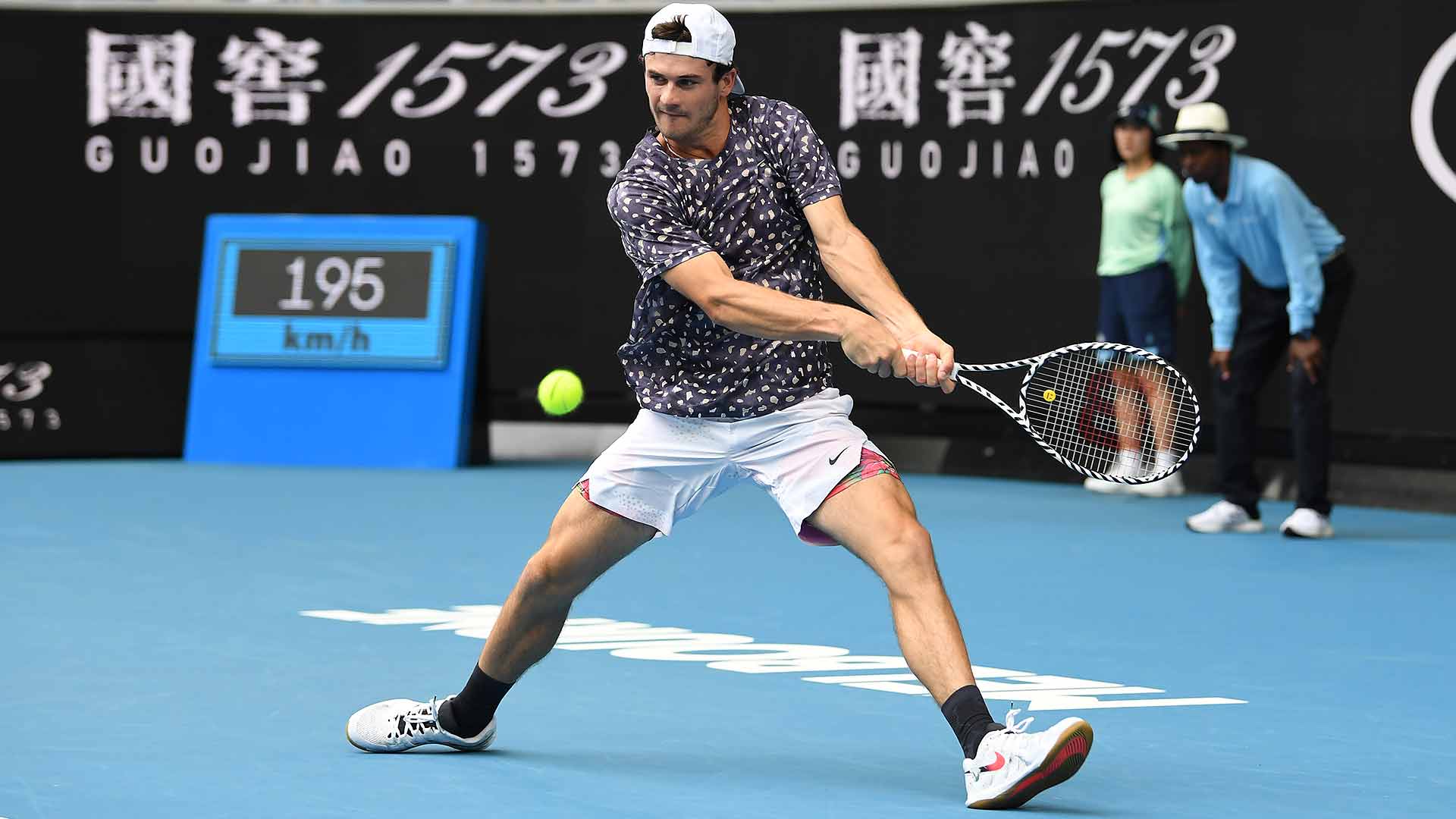 Tommy Paul reaches the third round of a Grand Slam for the first time on Wednesday at the Australian Open.” />
Tommy Paul reaches the third round of a Grand Slam for the first time on Wednesday at the Australian Open.” />
3) He Has An Experienced Coach In His Corner
Paul began working with Brad Stine near the end of the 2019 season. Stine has previously worked with former World No. 1 Jim Courier and two-time Grand Slam finalist Kevin Anderson. The former U.S. national coach spent the 2019 off-season with Paul and was impressed by the World No. 57’s professional approach.
”[The o]ff-season was phenomenal with him,” said Stine. “I was really impressed with his work ethic and attitude coming to the court every day.”
4) Fun Is Important
Introduced to the sport by his parents aged seven, Paul noticed he was having more fun on court than most players his age. On days where he lacked motivation, Paul made a conscious effort to prioritise fun on the court to keep his spirits high.
That same mindset remains to this day. The 2015 Roland Garros boys’ singles champion hopes his fun philosophy also provides fans in the stands with plenty of enjoyable moments.
“I want people to have fun watching me. I want them to see me having fun and I want them to enjoy watching it,” Paul said. “I don’t want to be a boring guy out on the court.”
5) A New City Means New Restaurants
Spending much of the year on the road, Paul loves to discover new restaurants during tournament weeks. During his title run at the Challenger event in New Haven last year, the Delray Beach resident visited Frank Pepe’s Pizzeria with fellow player Ryan Shane.
“Eating on the road is pretty much always eating out,” said Paul. “We try and find the best restaurants, restaurants that are famous in the area.”
The finances of British tennis “won’t be severely impacted” by the cancellation of Wimbledon, says chief executive Richard Lewis.
ATPTour.com reflects on the best moments from the All England Club
Since 1877, The Championships has witnessed some of the most important moments in tennis history. The grass courts of the All England Club have played an integral role in the careers of many of the sport’s greatest names, including Bjorn Borg, Boris Becker, Pete Sampras and Roger Federer.
Due to the COVID-19 pandemic, the biggest stars in the sport will have to wait another year to wear traditional all-white attire and compete for the biggest title in grass-court tennis.
ATPTour.com reflects on some of the most memorable moments from SW19.
1980: Borg, McEnroe Produce Instant Classic
Widely considered one of the greatest finals in Wimbledon history, four-time defending champion Bjorn Borg met first-time Wimbledon finalist John McEnroe in the 1980 final. A cool and composed Borg entered the match seeking his third straight Roland Garros-Wimbledon double. On the other side of the net, a fiery 21-year-old McEnroe was aiming to lift his second Grand Slam trophy after his 1979 US Open triumph.
Borg started slowly, but he charged back into the match and found himself on the brink of victory in the fourth set. The Swede earned seven championship points, but McEnroe saved each one and extended the match to a deciding set by winning a memorable 22-minute tie-break 18/16. In the decider, Borg raised his level on serve and broke through in the 14th and final game with a cross-court backhand passing shot to clinch a 1-6, 7-5, 6-3, 6-7(16), 8-6 victory and his fifth straight crown at the All England Club.
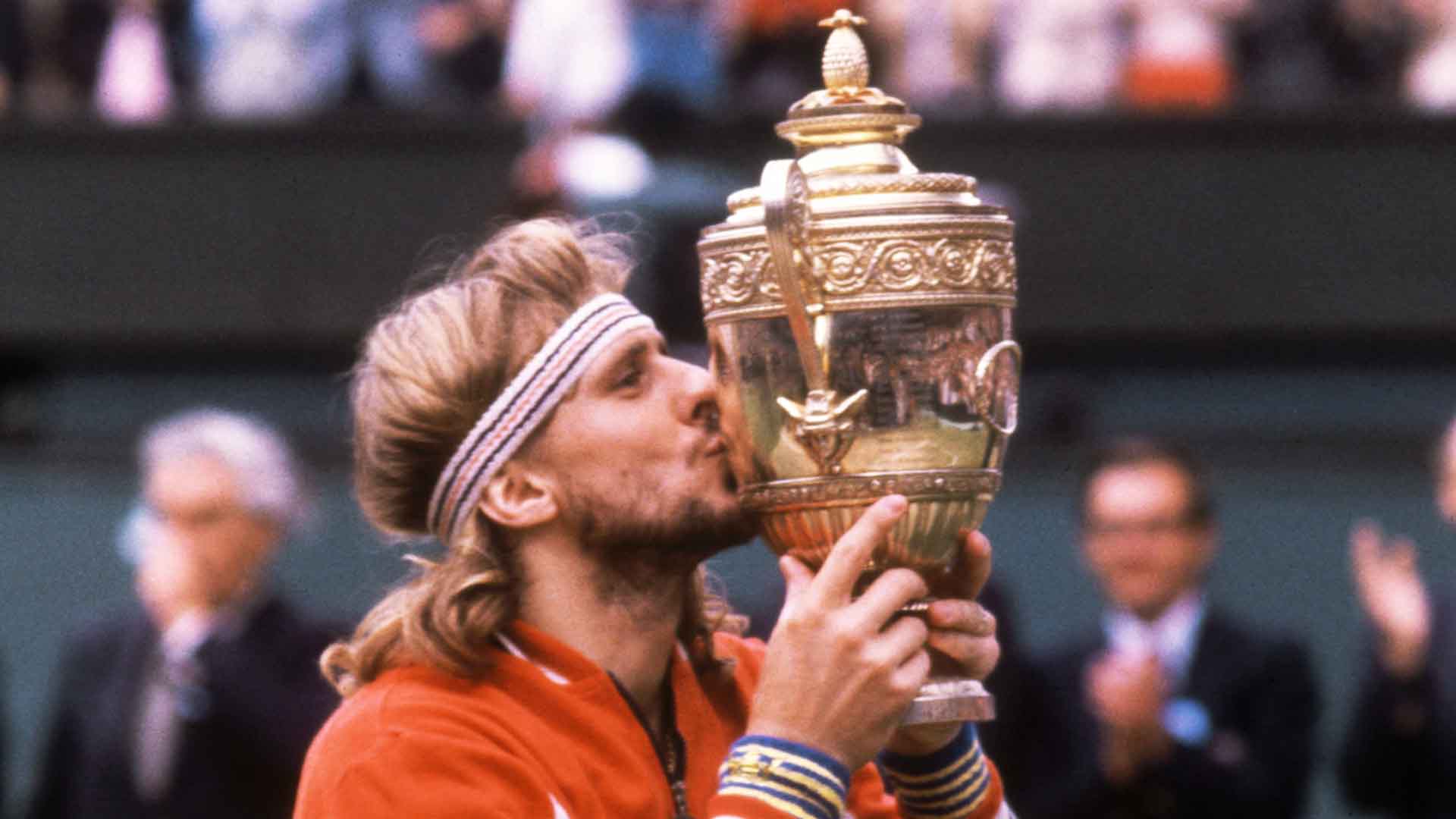 Bjorn Borg beats John McEnroe in five sets to claim the 1980 Gentlemen’s Singles title at Wimbledon.” />
Bjorn Borg beats John McEnroe in five sets to claim the 1980 Gentlemen’s Singles title at Wimbledon.” />
1985: The Youngest Champion
One week after lifting his maiden ATP Tour title at The Queen’s Club, Boris Becker arrived at SW19 for his second appearance at The Championships. The unseeded German survived back-to-back five-set encounters against Joakim Nystrom and Tim Mayotte, before overcoming Henri Leconte and Anders Jarryd in four sets to reach his maiden Grand Slam final against Kevin Curren.
After three hours and 18 minutes of action on Centre Court, the 17-year-old fired a huge serve out wide to complete a 6-3, 6-7(4), 7-6(3), 6-4 victory and become the youngest champion in the tournament’s history. Becker reached another six Wimbledon championship matches, including three straight finals against Stefan Edberg between 1988 and 1990.
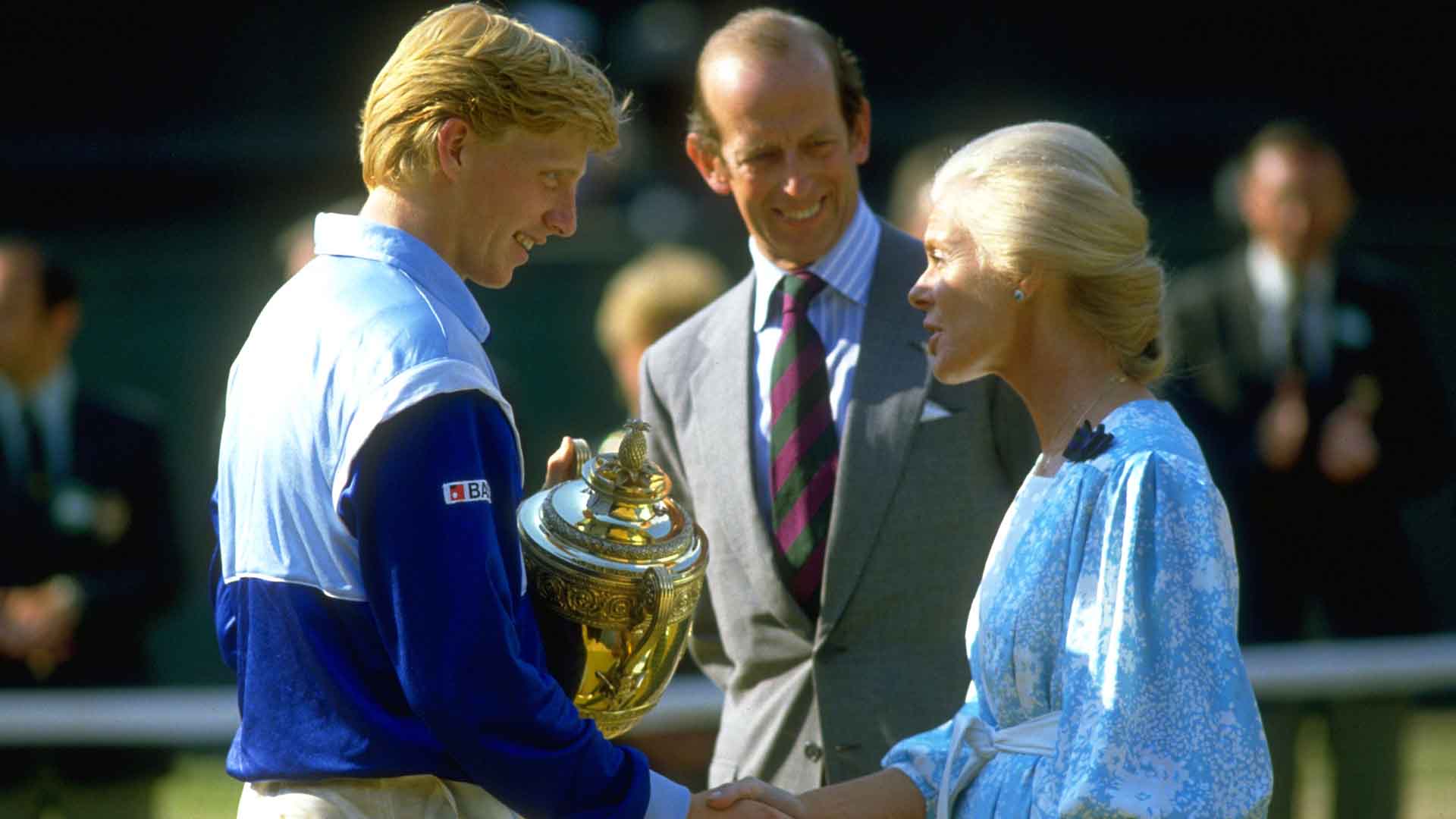 Boris Becker beats Kevin Curren to lift the 1985 Gentlemen’s Singles title at Wimbledon.” />
Boris Becker beats Kevin Curren to lift the 1985 Gentlemen’s Singles title at Wimbledon.” />
2000: Sampras’ Seventh
Between 1993 and 2000, Pete Sampras dominated The Championships. The American won 53 of 54 matches across eight appearances to tie William Renshaw’s then-record haul of seven titles at the All England Club. Sampras claimed three straight trophies from 1993 to 1995 and, after a quarter-final loss to eventual champion Richard Krajicek in 1996, the 6’1” right-hander returned to claim four consecutive titles from 1997 to 2000.
In the 2000 championship match, Sampras rallied from a set down to overcome Patrick Rafter 6-7(10), 7-6(5), 6-4, 6-2 for his 13th Grand Slam crown. The victory moved Sampras into first place on the Grand Slam titles leaderboard, breaking a tie with 12-time Grand Slam winner Roy Emerson.
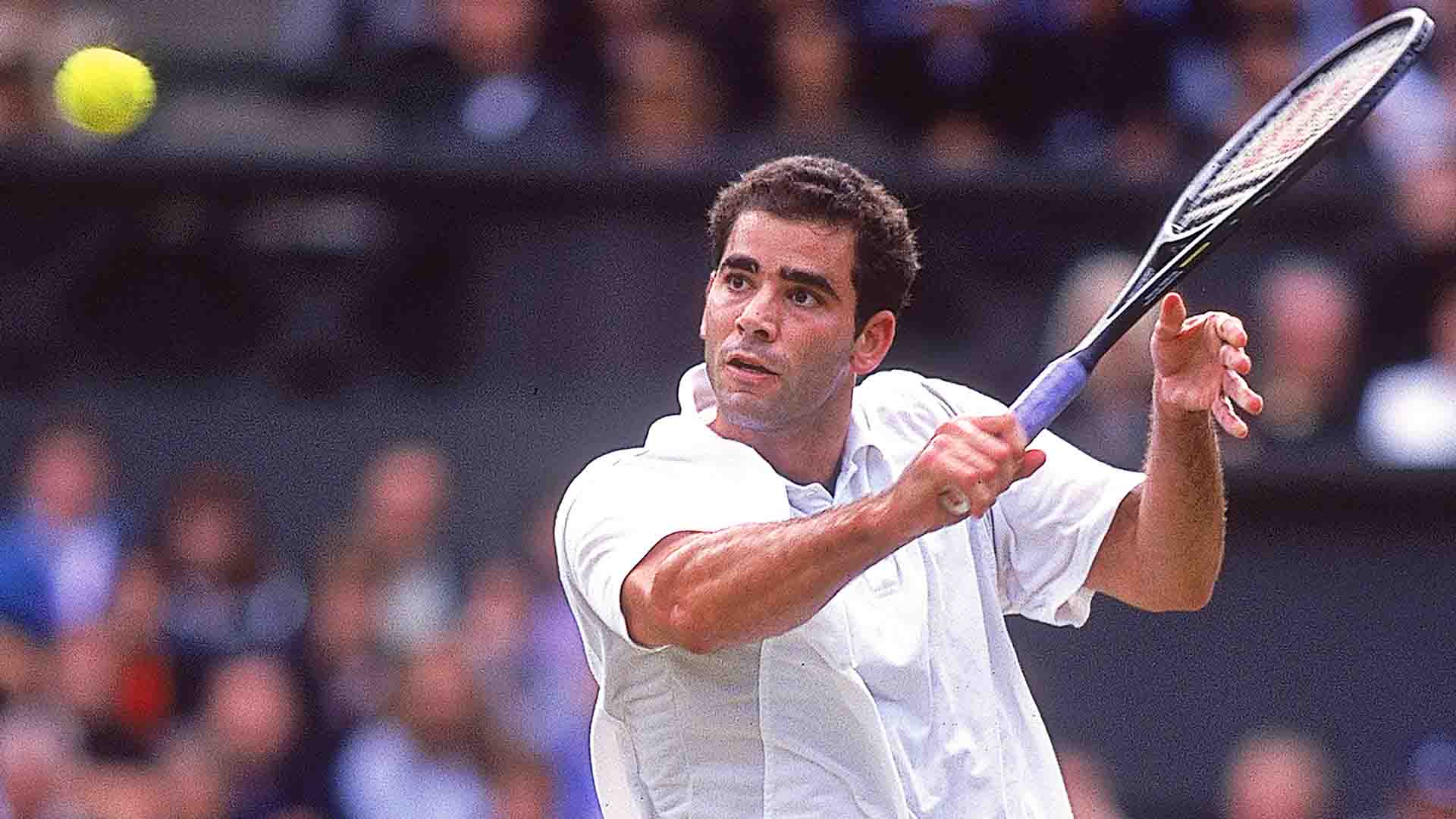 Pete Sampras lifted seven Gentlemen’s Singles titles at Wimbledon between 1993 and 2000.” />
Pete Sampras lifted seven Gentlemen’s Singles titles at Wimbledon between 1993 and 2000.” />
2001: Ivanisevic Wins ‘The People’s Final’
After finishing as runner-up on three occasions at SW19 during the 1990s, Goran Ivanisevic finally captured the Wimbledon trophy in 2001. Competing at No. 125 in the FedEx ATP Rankings, the 29-year-old rallied from two-sets-to-one down against home favourite Tim Henman in a three-day semi-final to face 2000 runner-up Rafter in a Monday championship match.
With 10,000 tickets available to fans in the Wimbledon queue, the 2001 final, known as ‘The People’s Final’, will be remembered for its incredible atmosphere. The stands of Centre Court were filled with Croatian and Australian flags and fans could barely contain their excitement as the match reached a fifth set. Ivanisevic made the crucial breakthrough with a forehand return winner at 7-7 in the decider, before clinching a 6-3, 3-6, 6-3, 2-6, 9-7 win on his fourth championship point. Ivanisevic is the only wild card to capture the Gentlemen’s Singles title in tournament history.
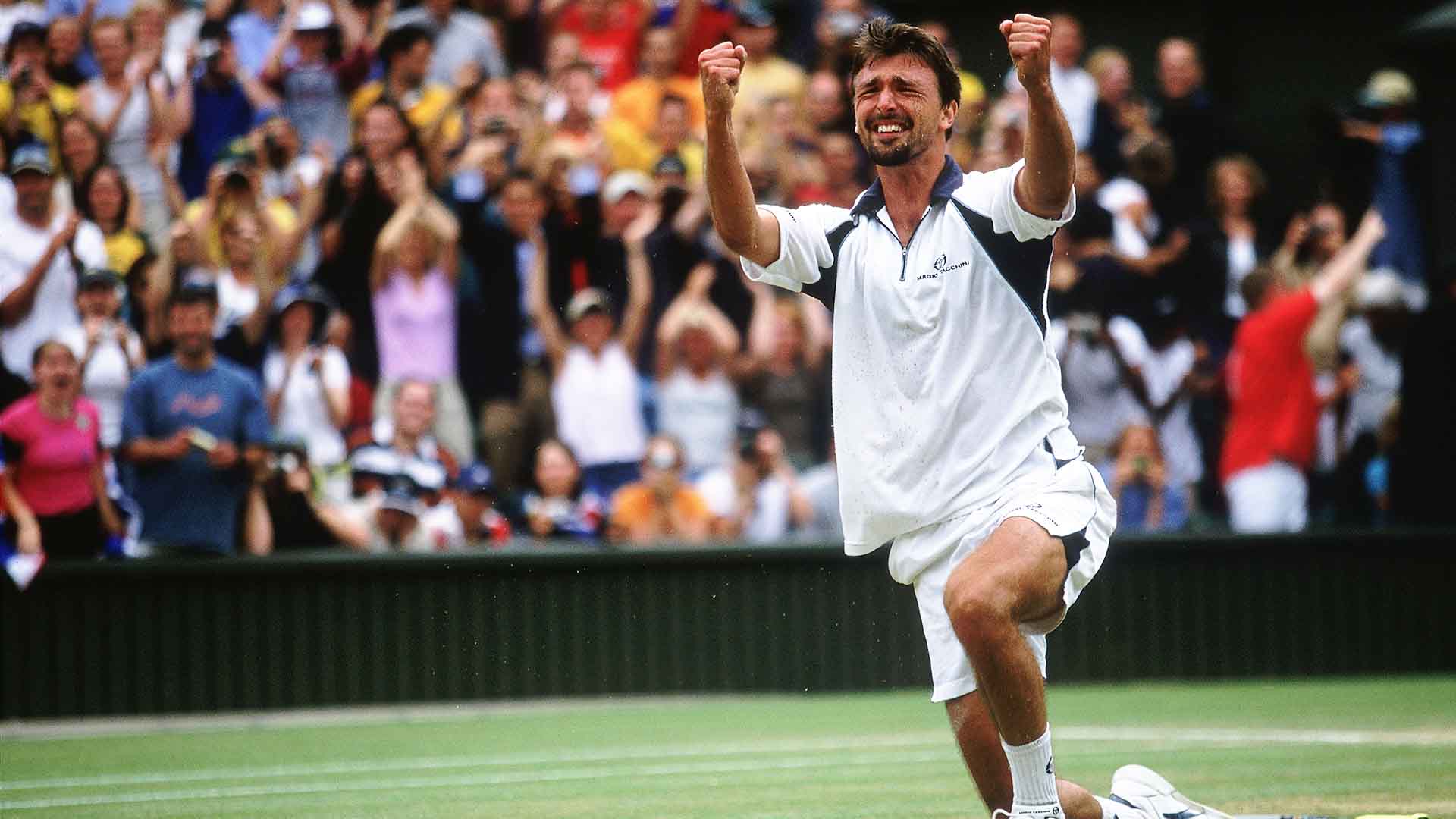 Goran Ivanisevic beats Patrick Rafter in five sets to capture the 2001 Gentlemen’s Singles title at Wimbledon.” />
Goran Ivanisevic beats Patrick Rafter in five sets to capture the 2001 Gentlemen’s Singles title at Wimbledon.” />
2008: Nadal Dethrones Federer
After losses to the Federer in the 2006 and 2007 finals, Rafael Nadal returned to SW19 in 2008 in the form of his life. Riding a 23-match winning streak, which included a 6-1, 6-3, 6-0 win against the Swiss in the Roland Garros championship match, Nadal entered a third straight Wimbledon final against Federer with confidence.
Across four hours and 48 minutes, in a final twice interrupted by rain, Nadal outlasted the five-time defending champion 6-4, 6-4, 6-7(5), 6-7(8), 9-7 across four hours and 48 minutes, in a final twice interrupted by rain, to claim his maiden Wimbledon crown at 9:15 p.m. local time. As Borg had done in the 1980 final, the Spaniard recovered from the disappointment of failing to convert championship points in a fourth-set tie-break to clinch the trophy. Nadal became the first man since Borg in 1980 to complete the Roland Garros-Wimbledon double and ended Federer’s all-time record 65-match winning streak on grass.
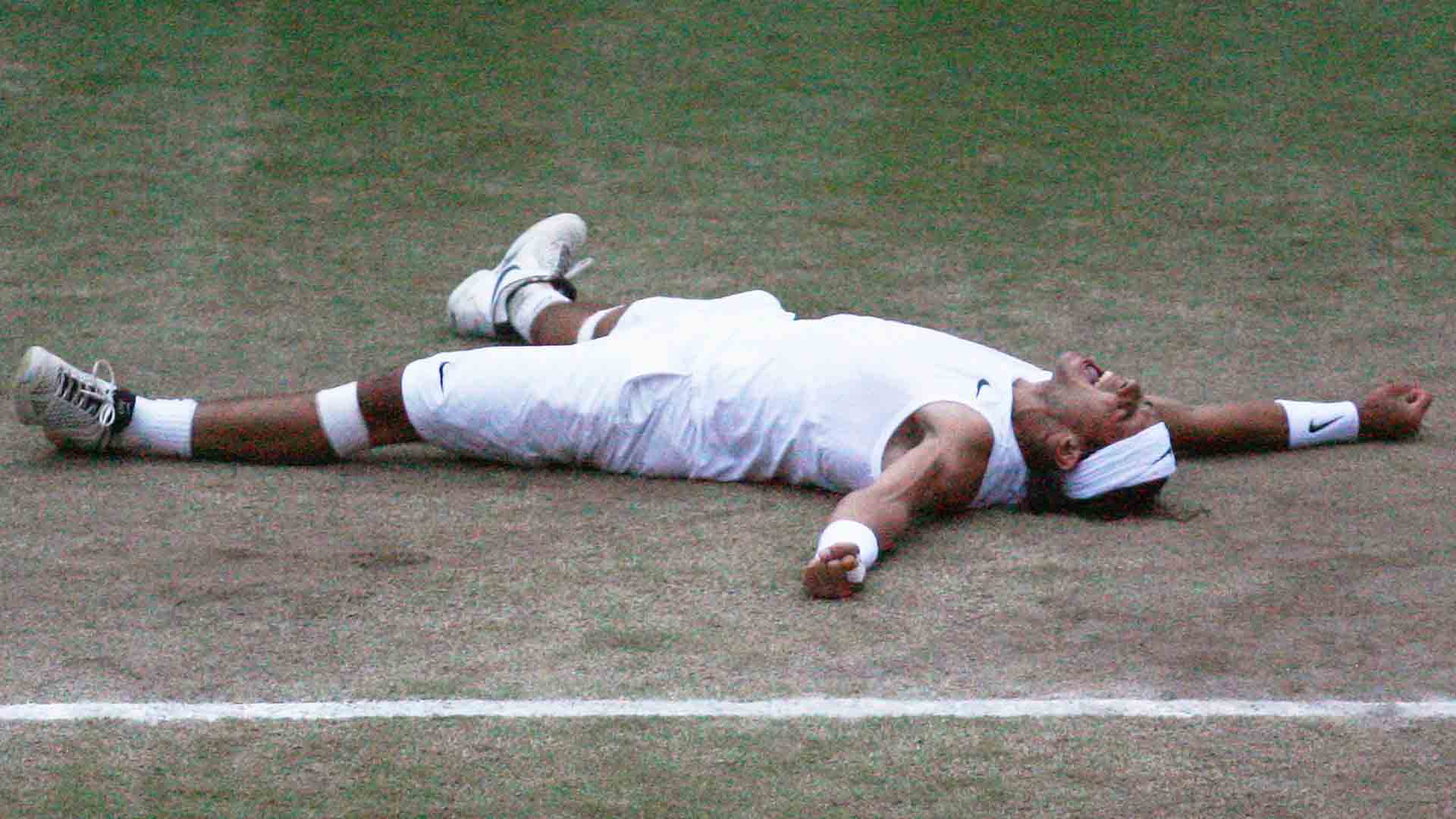 Rafael Nadal defeats Roger Federer in five sets to capture his maiden Wimbledon title in 2008.” />
Rafael Nadal defeats Roger Federer in five sets to capture his maiden Wimbledon title in 2008.” />
2013: Murray Ends 77-Year Wait
One year after falling to Roger Federer in his maiden Wimbledon final, Andy Murray returned to The Championships as a Grand Slam winner and an Olympic gold medallist in 2013. Entering the tournament after his third triumph at The Queen’s Club, Murray cruised through to the quarter-finals before comeback victories against Fernando Verdasco and Jerzy Janowicz. Backed by 15,000 fans on Centre Court and a further 4,000 supporters on Henman Hill, Murray faced Novak Djokovic, the man he beat to win his maiden Grand Slam title at the 2012 US Open.
After edging the opening two sets, Murray recovered from a 2-4 deficit in the third set to serve for the trophy at 5-4. As the Centre Court crowd struggled to contain its excitement, Murray clinched a marathon 11-minute game to become the first British player to capture the Gentlemen’s Singles trophy at Wimbledon since Fred Perry in 1936.
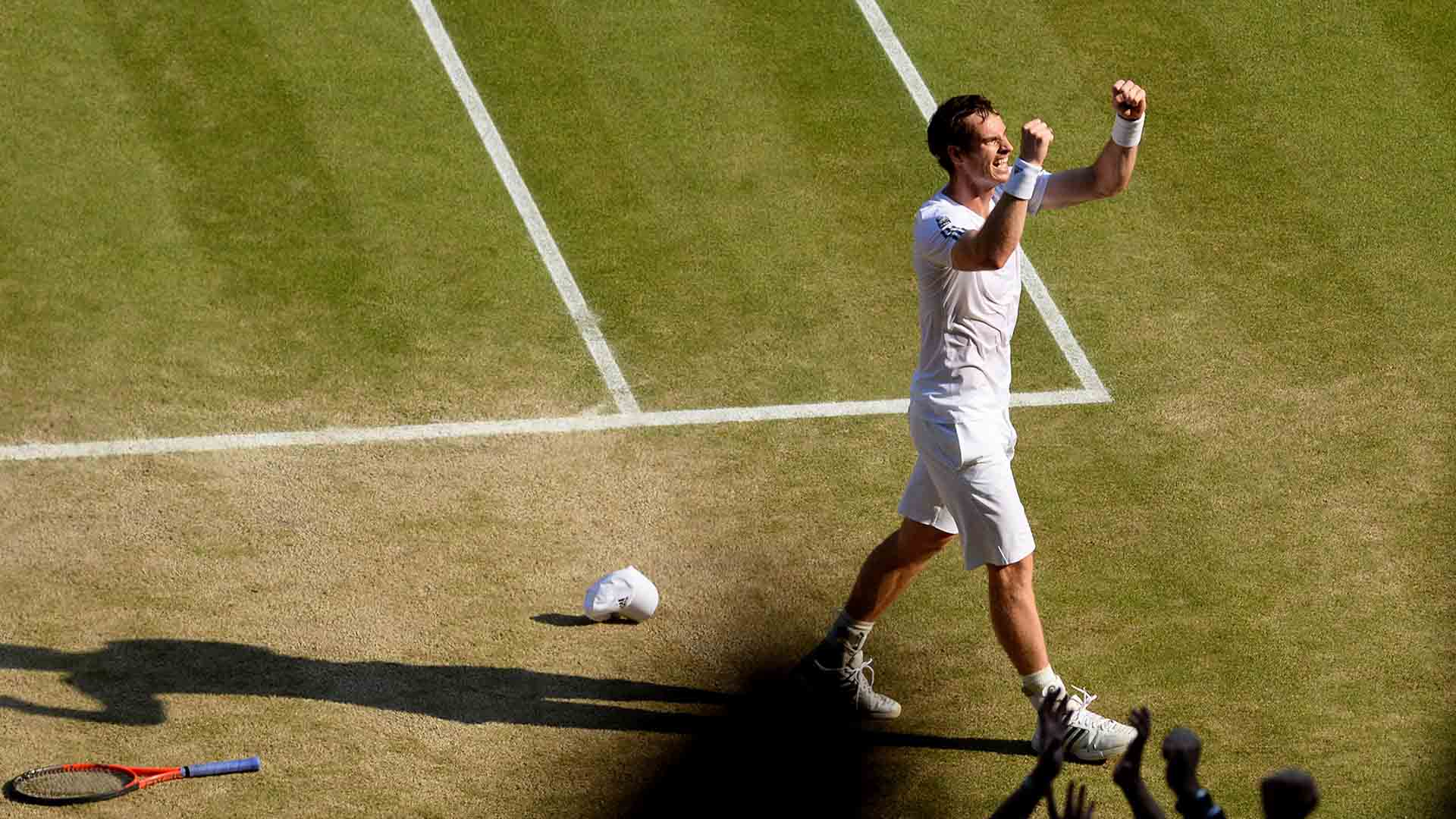 Andy Murray defeats Novak Djokovic in straight sets to claim his maiden Wimbledon title in 2013.” />
Andy Murray defeats Novak Djokovic in straight sets to claim his maiden Wimbledon title in 2013.” />
2017: Federer Makes History
Five years after lifting a record-equalling seventh Gentlemen’s Singles trophy in 2012, Federer arrived at the All England Club in 2017 in top form. The 35-year-old, who ended his 2016 season after Wimbledon to recover from knee surgery, was chasing his second major trophy of the year after lifting his 18th Grand Slam title at the Australian Open. Federer had also won back-to-back ATP Masters 1000 crowns in Indian Wells and Miami and his ninth Halle trophy earlier in the year.
After advancing to the championship match with victories against Milos Raonic and Tomas Berdych, Federer continued his run of form in the championship match to charge past Marin Cilic 6-3, 6-1, 6-4 in one hour and 41 minutes. With his final victory, Federer broke a tie with Renshaw and Sampras to become the first player in tournament history to lift eight Gentlemen’s Singles trophies. He joined Bjorn Borg (1976) as only the second man in the Open Era to claim the title without dropping a set.
 Roger Federer beats Marin Cilic in straight sets to capture a record eighth Gentlemen’s Singles title at Wimbledon.” />
Roger Federer beats Marin Cilic in straight sets to capture a record eighth Gentlemen’s Singles title at Wimbledon.” />
2019: The Longest Final
Djokovic and Federer in 2019 met in the Wimbledon final for the third time. Alongside Federer’s meeting with Nadal in the 2008 championship match and Borg and McEnroe’s 1980 classic, the 2019 final will be remembered as one of the best finals in Wimbledon history.
With Federer seeking his 21st Grand Slam title and Djokovic aiming to close the gap in the all-time Grand Slam titles leaderboard with his 16th trophy at the level, both men found their best form on Centre Court. Federer held two championship points at 8-7, 40/15, in the fifth set, but Djokovic recovered to force a 12-12 tie-break. In the first Gentlemen’s Singles match to be decided by the newly-introduced 12-12 final-set tie-break, the Serbian showcased his best retrieval skills in crucial moments to claim a 7-6(5), 1-6, 7-6(4), 4-6, 13-12(3) victory after four hours and 57 minutes. Djokovic became the first man since Robert Falkenburg in 1948 to lift the Wimbledon trophy after saving championship points in the final, winning the longest tournament final in history.
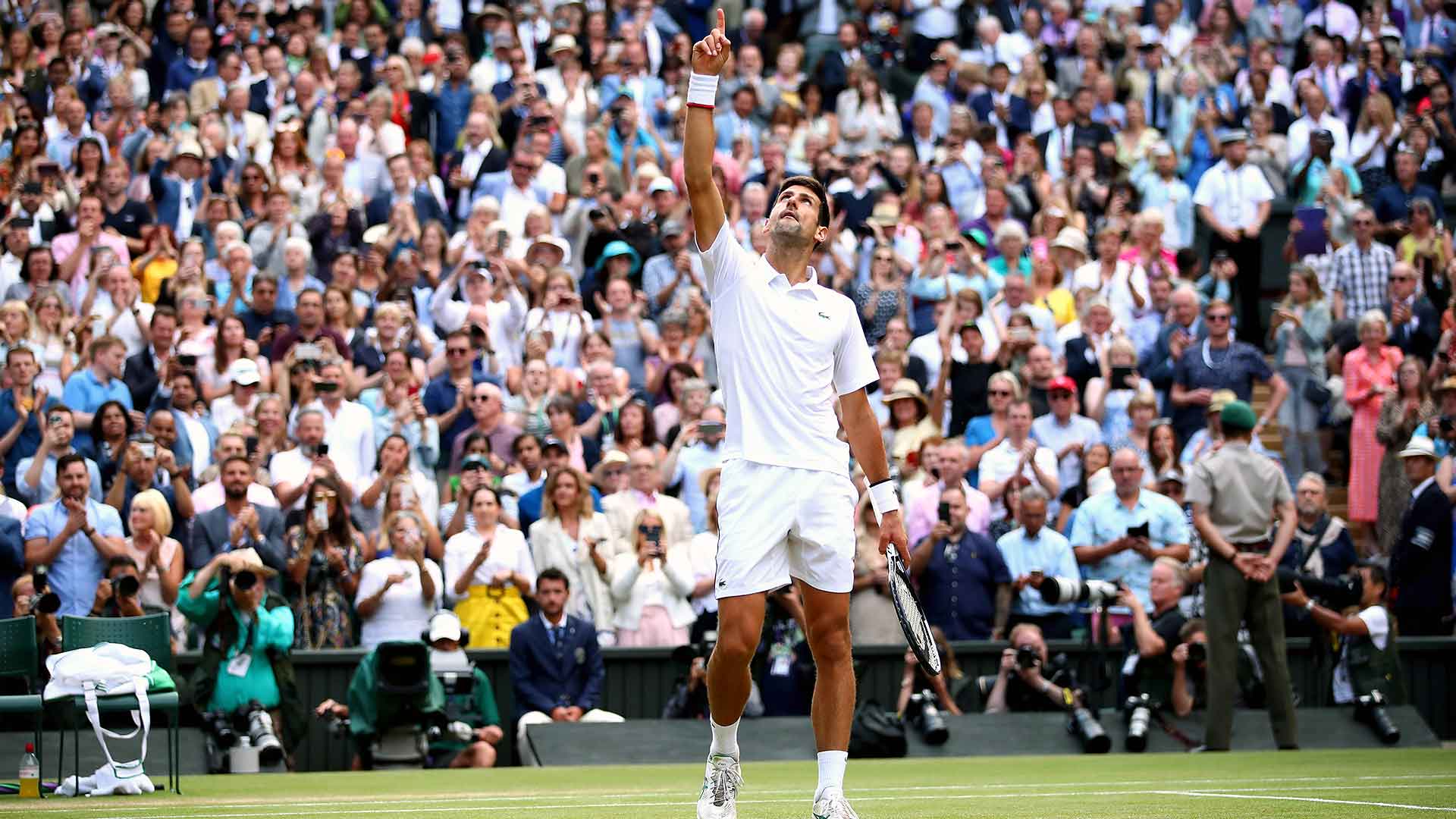 Novak Djokovic celebrates winning his fifth Wimbledon title on Sunday.” />
Novak Djokovic celebrates winning his fifth Wimbledon title on Sunday.” />